|
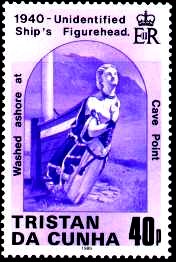
|
Maritime Topics On Stamps :
Figureheads !
|
Unidentified figurehead washed ashore,
Cave Point, Tristan da Cunha.
|
|
Figureheads always served several different functions. On the one hand they act as pretty
ship decorations, on the other hand they also had a symbolic meaning. This meaning was often a
mix of religious beliefs and superstition. Some sailors believe in the ship as a
living being and the figure at the bow as her soul. The figure had to protect the ship
against storms and evil seaghosts. And it should lead the ship on the right course.
Then there were some figureheads with the only purpose to frighten and scare away enemies.
Fearing opponents always have severe psychological combat disadvantages.
On small ships the weight of a figurehead was often used for trimming purposes.
The weight influenced the capablities of a sailing ship, turning it with the bow
into or off the wind.
|
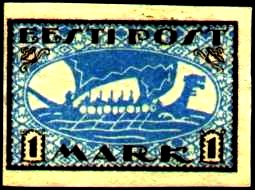
|
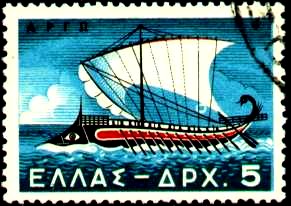
| |
In the beginning of shipping divine symbols, holy animals or both decorated the vessels.
For example all ships of the queen Hadschesput carried a bend lotos blossom. On Roman and Greek ships animal heads, crocodiles, seahorses, naked men and busts of god's were a common sight.
To the right you can see a single eye painted onto the bow. With this eye the ship should find
its way through all seas. At the stern is a head of a goose, the symbol for eternal floating.
The left stamp shows a viking boat with a big dragon head. This head should scare enemies and
cause terror in their hearts. According to legend some dragon heads were removable, because
showing them while sailing in their home seas was strictly forbidden.
|
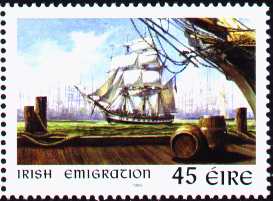
|
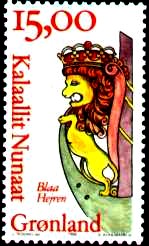
| |
In the 14th century the bulging roundships disappeared. More slender ships, the
galleons, were build. A bowsprit was fixed to the front part of the stem, called a
galleon to enable the ships to set more sails. Below this bowsprit was
an excellent place for the ship's figurehead.
In those days dragons, unicorns and other creatures of legend were used as figureheads.
The legendary 'Golden Hind' of Sir Francis Drake carried an appropiate golden hind as a
figurehead.
The most popular figurehead in the 17th and 18th century was the lion,
a symbol for bravery and strength.
|
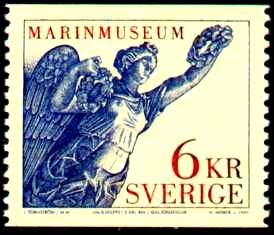
|
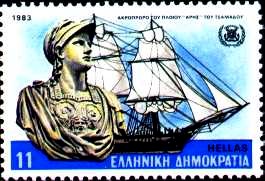
| |
During the 18th century the animals were replaced by gods and heroes. To the left you can see
the Roman goddess of victory 'Victoria' (named 'Nike' in Greek) depicted as an angel with
garlands made of laurel and oak leaves. She was used as the figurehead of the ship-of-the-line
'Karl III'. To the right, Ares, the god of war in his armour.
He was the figurehead of a brig with the same name.
|
|
Popular belief sees figureheads as all female and beautiful beings. This is disproved by
history and stamps alike. The amounts of depicted men and women are nearly equal.
To the right you can see a war hero at the bow of the steam corvette 'Karteria'.
|
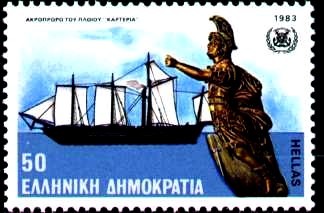
|
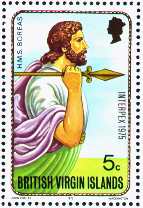
|
Figureheads are often designed and built in reference to the name of the ship.
This stamp shows Boreas, the god of the northern winds, aboard the British
frigate 'HMS Boreas'.
|
|
Another example for a ship's name and a corresponding figurehead is the victorian nymph
abord the British destroyer 'HMS Nymphe'.
|
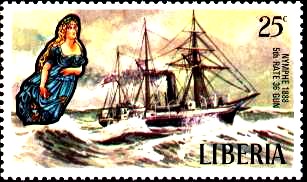
|
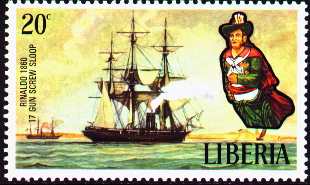
|
The screw corvette 'Rinaldo' with the robber chief Rinaldo Rinaldini as figurehead.
This British man-of-war fought against pirates in the Malakka Strait.
Rinaldo was a 'noble' robber who did not allow any violence against women.
Maybe this was the reason for a British ship to carry him as it's figurehead.
|
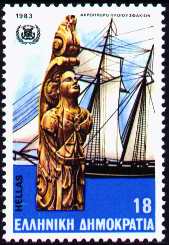
|
In the 18th and 19th century more and more female figureheads started to appear
and the term 'Wooden Angel' was created. Many of these angels had a large
bosom but they were always properly dressed unlike their ancient counterparts.
|
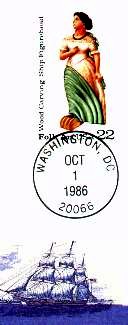
|
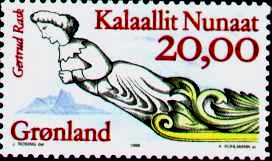
|
Most female figureheads did not represent any specific 'real life' person.
Nevertheless it was not uncommon for a shipowner to choose the name of his wife for his
ship's name. Shown here is an example for such naming: the Danish steam schooner 'Gertrud Rask'.
|
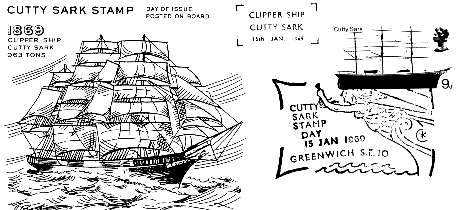
|
Die Legende der Cutty Sark:
One day after many drinks the Scottish farmer Tam O'Shanter rode home through a stormy night. During
a flash of lightning Tam saw a group of witches dancing in a churchyard. Most of them
looked old and ugly but there was a pretty young and beautiful one. She wore a titillating, short shirt, which is called a 'cutty sark' in a Scottish dialect.
Tam stopped his horse to take a look at the wonderful dancing witch. Suddenly he
delightedly cheered: 'Fantastic, Cutty Sark'! In this very moment the lightning vanished.
Tam became frightened and started to flee home as fast as his horse could go. But the witches pursued him and the beautiful one drew close and grabbed the tail of his horse. Tam's end seemed to be near.
But the horse broke free, leaving its tail in the hand of the witch. Tam escaped over a bridge, as
the witches fortunately were unable to cross running water.
The figurehead 'Nannie' of the ship 'Cutty Sark' had no horse tail in her hand, but often
sailors put an end of a rope into her stretched out hand. On the stamp above you can see
a part of the 'tail rope'.
The famous tea-clipper 'Cutty Sark' was launched in 1869. Today the ship is berthed in a drydock
at London village Greenwich. The ship is a museum and carries an exhibition about figureheads
aboard.
|
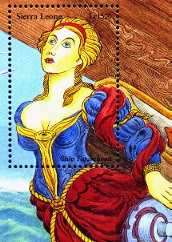
|
When the steam ships with their straight bows pushed away the sailing ships the time of the
figureheads came to an end. Later on, when vault bows made a comeback, the ships of the Fred
Olsen Line had figureheads made of steel.
Today only the marine sailing ships used for training purposes carry figureheads.
The 'Gorch Fock' carries an albatros, the 'Sagres' a bust of Henry, the navigator, The 'Christian
Radich' utilizes a woman with blond hair, the 'Esmeralda' a condor, the 'Amerigo Vespucci'
carries the discoverer of the same name, etc. etc....
|
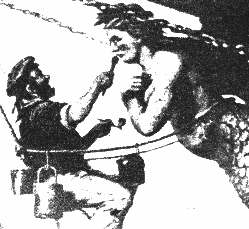
|